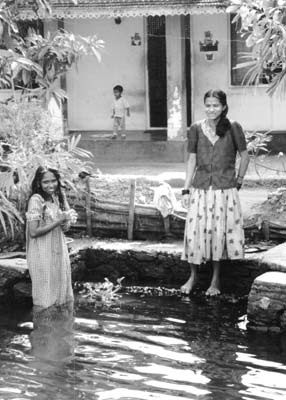Around the world in 80 days
My husband and I have taken several trips around the world. On our most recent such trip, in 2005, dubbed “Around the World in 80 Days” (actually 83), we shopped in Hong Kong’s wet market, had an elephant massage in Thailand (my husband’s back massaged by an elephant’s foot), visited the National Museum of Bahrain and soaked in Iceland’s Blue Lagoon.
You can, too. It’s easier and less expensive than you may think. But long-term, independent, international travel requires some special planning.
TICKETING — The biggest obstacle is lack of time. Using a circle ticket or multidestination ticket is the most economical way to travel to several destinations. However, these types of tickets are relatively unknown among U.S. travelers because of most Americans’ limited vacation time.
The most popular itineraries derive from “Circle the Pacific” and “Circle the Globe” tickets. A prepackaged “Circle the Globe” ticket can start as low as $1,199, but it depends on the season and the destinations. Agents can purchase the cheapest air tickets for each segment of travel, making use of several airlines. Certain restrictions apply, and a portion of overland travel is sometimes necessary. Usually, travel must be completed in a year, and all flights are confirmed upon payment. Regardless, parameters are not excessively restrictive.
We have taken three multidestination trips of about three months each, the others being a circling of the Pacific in 2002 and a circling of the South China Sea in 2003. We usually leave around the second week in January and return the first week of April.
After much searching, we have found the best deal, by far, to be with Air Brokers (685 Market St., Ste. 400, San Francisco, CA 94105; 800/883-3273 or www.airbrokers.com), which is the only firm we have used. Other airline brokers are World Travellers’ Club, Inc. (545 Sutter St., Ste. 202, San Francisco, CA 94102; 800/693-0411 or www.around-the-world.com) and Air Treks (301 Howard St., Fourth Floor, San Francisco, CA, 94105; 877/247-8735 or www.airtreks.com).
To keep the cost at a minimum, stick with the routes offered by partner airline groups and plan your own side trips. For example, Hong Kong is often part of the ticketing. From Hong Kong it is easy and economical to visit southern China by train or Macao by ferryboat.
DOCUMENTATION — A passport is necessary, plus many countries require a visa, which is permission given by a country to enter. To find out if a visa is required, check http://travel.state.gov/foreignentryreqs.html.
Usually, a visa can be obtained by mailing an application along with a money order (costs vary), photos (2"x2") as required and your passport to the country’s embassy. Plan on at least two weeks’ processing time per visa. Applications can be downloaded from the country’s embassy website. Locate a country’s website at www.embassy.org.
While most visa transactions can be done by mail, a few countries, such as China, no longer will accept mail-in applications. In that case, contact an agency such as American Passport Service (800/841-6778 or www.americanpassport.com), and for a fee they will obtain the necessary visas.
Some countries, such as Cambodia and Bahrain, issue short-term visas upon arrival. Take along extra visa photos. Be cognizant of restrictions and expiration dates on passports and visas.
RESERVATIONS — When it comes to planning, nothing replaces a good guidebook and promotional material from national tourist offices. Rates for hotels and tours are usually less expensive when booked after you arrive. However, arriving in a foreign country without reservations often gets a visit off on the wrong foot. Consider reserving a hotel for the first night or two in each country. That will allow you time to become acculturated and make travel arrangements.
Travel guides now include e-mail addresses for accommodations and travel agencies. Also, most airports and train stations have tourist offices that will help you find accommodations and plan tours.
PACKING — Remember the adage “Take out half of the clothes you’ve packed and double the amount of money.” Believe it or not, all that you need for a 3-month trip can be packed in one carry-on bag plus one small bag that fits under the airplane seat.
Choose clothing all in the same color family that can be mixed and matched. Plan on layers for colder destinations. Most hotels provide laundry service, and many now have washers and dryers.
It is possible to buy almost anything you may need anywhere in the world. Mail home souvenirs and other unneeded items. Preprinted address labels facilitate sending postcards and packages. Carrying a credit card and/or ATM card means that you will need very little cash.
HOUSE CARE — If you have someone living in your house while you are gone, leave them the names of suggested repair people.
Lights on a timer will make your house look lived in. Stop newspaper and mail deliveries. Depending on your location and/or the season, have your lawn mowed or the driveway plowed.
Have someone check on your house periodically. Let the local police know you will be away.
MISCELLANY — Check with your physician to see if any immunizations or special precautions are recommended for the areas you are visiting. It never hurts to carry a prescription medication for intestinal problems, just in case.
Try to not travel too fast. Plan “mini-vacations” or rest days every week or 10 days. Savor those special locations by staying longer. Leave a detailed itinerary with relatives, pay your bills online, and keep in touch with family via e-mail. If your e-mail server cannot be accessed from afar, set up a free account on Yahoo. Make sure all of the necessary addresses are in your account’s address book.
Also, e-mail yourself your itinerary with flight times, confirmation numbers and other important data just in case something goes missing while you are traveling. Internet cafés can be found almost everywhere worldwide.
English is a connecting language, so if you speak English communicating is not a major issue. Most places that deal with international tourism have English-speaking personnel.
GET GOING — Pack your bags and see the world. Walk across the Bridge over the River Kwai; attend a Cao Dai service in Vietnam; dine at a traditional hangi (a meal cooked in the ground) and learn the Maori huka (war dance) in New Zealand; study the Aboriginal song lines on Uluru (Ayers Rock); take in a Kathakali performance in India, and walk in the footsteps of Caesar on Italy’s historic Appian Way.
You will be amazed at how friendly everyone is, how easy it is to get around the world and how time flies. On the last leg back into the United States, you will be planning your next multidestination trip.
SANDRA SCOTT
Mexico, NY



